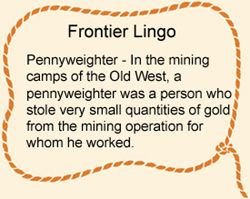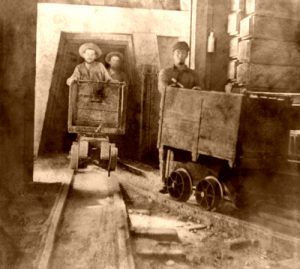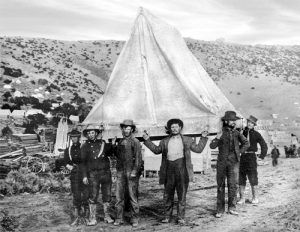Mining History in the United States – Legends of America (original) (raw)
By Albert S. Bolles in 1879
Gould and Curry Miners, Lawrence and Houseworth, 1866.
The hope of finding mineral treasure was one of the incentives that led the early colonists to America, who were quite diligent in searching for metals. All along the Atlantic Coast, almost immediately after the first settlements, discoveries were made of silver, lead, copper, iron, tin, antimony, coal, and other valuable minerals. Still, they were found generally in small quantities and, in competition with foreign production, the working of mines was frequently found unprofitable. Then, too, the presence and hostility of Indians made such enterprises dangerous.
Iron ore was sent to England from near Jamestown in 1608, the year after Virginia was first permanently settled. In 1620, 150 skilled workmen were sent to the colony to erect and operate ironworks. However, an Indian massacre two years later put a discouraging end to the proceedings. Another discouragement grew out of such blunders as the supposed discovery of gold in Virginia by Captain John Smith. A shipload of glittering dust was sent to England, and there, it was pronounced to be nothing but iron pyrites.
However, the plucky colonists persevered despite all depressions and obstacles and made very creditable beginnings. It was resumed permanently in 1715. The metal was found in Massachusetts in 1628; later, a company was formed to work it in 1643. Rhode Island, Connecticut, New York, and Pennsylvania followed suit. Penn had discovered iron as early as 1683, but no forges were mentioned on his grants earlier than 1719-20. began in Missouri, then belonging to France, in 1720, and the old Southampton silver-lead mine was opened in Massachusetts in 1765. Copper mining was first heard of in Connecticut, the Simsbury mines being worked as early as 1709, but they were abandoned as unprofitable about the middle of that century. The Schuyler Mine, near Belleville, New Jersey, was discovered in 1719 and is historic as the scene of building the first steam engine in America in 1793-94. The whites first mined Lake Superior copper in 1771 in small quantities. In the early colonial days, the settlers used wood for fuel and charcoal for the forge and smelting works. Coal, however, was found in Rhode Island in 1768 and mined for use. The great bituminous seam near Pittsburgh, Pennsylvania, was struck in 1784. Previous to this time, coal was found in quantities in Virginia; canals were cut, connecting parallel rivers to facilitate transportation. By 1789, quite an export trade with adjacent colonies had been built up.
 These and other metals were found at numerous other points along the Atlantic seaboard before the American Revolution. Smelting works and forges were erected to reduce the ores, some of which were exported. The home government discouraged the manufacture of metals in this country, though, at that period, it was a damper upon them. From these humble beginnings, slow advances were made for several decades. By cutting off supplies from England and creating a special demand for iron and copper ordnance, lead bullets, and other metals for domestic and other implements, the Revolutionary War gave a peculiar stimulus to mining. However, the army drained the country of men, leaving few for such occupations.
These and other metals were found at numerous other points along the Atlantic seaboard before the American Revolution. Smelting works and forges were erected to reduce the ores, some of which were exported. The home government discouraged the manufacture of metals in this country, though, at that period, it was a damper upon them. From these humble beginnings, slow advances were made for several decades. By cutting off supplies from England and creating a special demand for iron and copper ordnance, lead bullets, and other metals for domestic and other implements, the Revolutionary War gave a peculiar stimulus to mining. However, the army drained the country of men, leaving few for such occupations.
It was not until the early 19th Century that there were marked strides in the mining business. In 1820, attempts were made to mix anthracite coal with charcoal in iron smelting. However, the experiment was unsuccessful until 1831, when the hot blast was invented; then, both the coal and the iron industry took a tremendous start. In 1835, lead mining received a wonderful impetus in Missouri and Iowa from discoveries.
Virginia City, Nevada Savage Works Mill, by Timothy H. O Sullivan, 1867.
Copper mining was revived along Lake Superior in about 1842 and made a sudden jump. The California gold fever of 1849 began the search and procurement of that metal on a considerable scale. Petroleum came prominently into notice for the first time in August 1859, when the Drake Well struck oil, and the Comstock Lode was discovered in Nevada that same year and laid the foundation of the silver mining business.
A review of mining history during this important period shows that our operations have been characterized by intense excitement and magnified speculative speculation, gross blunders, and great waste. Says Kimball, the character of it “is an instructive narrative of fluctuating fortune, ranging through all the intermittent vicissitudes of prosperity and stagnation, of factitious inflations and calamitous recoils, of blind delusion and credulity, of stolid unbelief, of highest popularity, and general distrust.”
The possibility of making a great deal of money in a short time always crazes people, and the discovery of large deposits of metal, both the baser and the precious, affords such inviting possibilities to the workman and the capitalist. And so, in the case of each of the great discoveries of lead, copper, gold, oil, and silver, a large proportion of the country’s population has been rendered frantic. An immense rush has set in toward the center of interest; fortunes large and small, often augmented by extensive borrowing from credulous friends and relatives, have been invested in land claims and stock companies to work them; towns and villages have sprung up almost in a day, like Jonah’s gourd. The hopes of but few out of many would be realized; disappointment and ruin ensued; and not only were poverty, sickness, and death often the result, but whole towns of the mushroom type have been almost as suddenly wiped out of existence.
Eldorado County, CA Miners.
In this mad rush of greed and excitement, other blunders were made besides investing in unprofitable lands. Furnaces for smelting were located without due regard for getting fuel; costly machinery for crushing ore was bought and forwarded to the scene of action without knowing whether ore would be found at all or whether the apparatus was suited to the kind of ore discovered; new processes for extracting metal were resorted to, without reliable information as to their value; and frenzied speculators committed other such ruinous mistakes.
There was also an enormous waste of valuable minerals as a consequence of this same impetuous desire for wealth. In the lead regions of the Mississippi Valley, argentiferous galena was quite common, and often, the lead was entirely wasted in the extraction of the little silver. In the coal regions, especially before the organization of the large companies and their combination in monopoly, only the richer measures would be worked, leaving a large quantity of inferior yet valuable coal on higher levels to be lost by caving.
Such recklessness in handling was practiced that a third to a half of the product was lost. The same state of things was found in the silver country. Mines were neglected as soon as the rich surface deposits were procured, and the accumulation of water and rubbish made it next to impossible to work what were paying shafts. But, by the latter half of the 19th century, a reaction set in these regards, and the extravagances steadily began to decline.
The two great causes, which, after the discovery of our great resources and the passion for wealth, have stimulated American mining, are the government’s general policy of encouragement and the advancement in mechanics and natural science. Under the old English laws, the crown was entitled to the gold and silver found on government lands and a certain proportion of other minerals. But, in this country, although the legislation was very slight until the late 1800s, the gold and silver miners of the Pacific Coast were ruled only by self-made regulations; the government favored the free occupation and investigation of the rocks for minerals and facilitated the cheap purchase and lease of mining lands. There has also been a protective tariff on foreign metals; the heaviest has been since 1861, which has greatly promoted the development of our iron, copper, coal, and other minerals.
Skidoo Mine and Mill.
Among the most serviceable inventions in practical mining and metallurgy in the late 19th century were the California stamp mill for crushing quartz, the mercury amalgamation process for gold, the panning process for silver, the hydraulic process of gold mining in alluvial regions, the application of new explosives to rocks, new methods of drilling, new blast-furnaces, and new methods of converting iron into steel.
Albert S. Bolles, 1879. Compiled and edited by Kathy Alexander/Legends of America, updated April 2024.
About the Article: The article first appeared in a book by Albert S. Bolles, entitled Industrial History of the United States, Volume IV, in 1879. Published by the Henry Bill Publishing Company, Norwich, CN. Bolles was a lecturer in Political Economy at Boston University, editor of the Banker’s Magazine, also lectured on banking and trusts at the University of the City of New York, and wrote several other books, including The Financial History of the United States, The Conflict Between Labor and Capital, and Practical Banking.
See our Mining Photo Gallery HERE
Also See:



